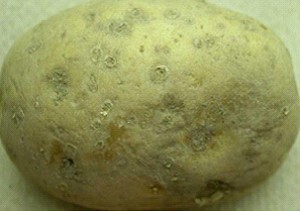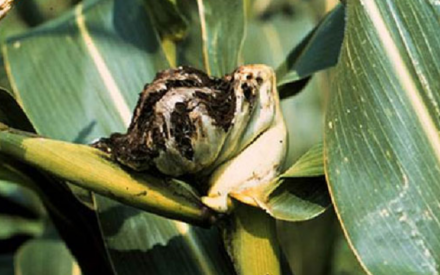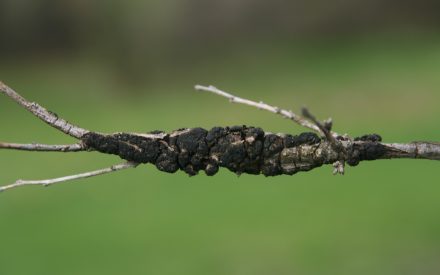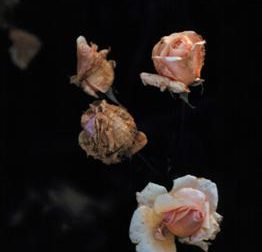What is powdery scab?
Powdery scab is a potentially serious disease of potatoes that occurs worldwide in regions where potatoes are grown, including Wisconsin. Although powdery scab primarily causes cosmetic, if unsightly, skin blemishes of potato tubers, the pathogen that causes the disease can transmit another, more serious potato pathogen, Potato mop-top virus (PMTV). PMTV was first detected in Wisconsin in 2020. This virus can cause severe losses and can limit a seed potato producer’s ability to sell to certain foreign markets. In addition, blemishes caused by powdery scab can serve as entry points for other pathogens, such as those that cause late blight, pink rot, dry rot and black rot.

What does powdery scab look like?
Tubers are infected through lenticels, eyes, or wounds. Initial symptoms of tuber infection are sunken purple-brown lesions that are followed by pimple-like swellings. As lesions mature, they break through the potato skin and develop into shallow depressions that contain a mass of powdery spore balls (called cystosori) surrounded by thin, raised remnants of the outer tuber skin. When infections develop in wet soils, the lesions deepen and become open cankers. Infections of roots and stolons can also occur, and first appear as necrotic spots, that later become small, white to tan-colored galls. As galls mature, they enlarge, turn brown and finally break open releasing cystosori into the soil. Because powdery scab symptoms appear on below-ground parts of the potato, infections may not be noticed until harvest. If symptoms have not fully developed by harvest, they may continue to develop in storage. At various stages of development, powdery scab can be mistaken for common scab, potato wart, black scurf, and root-knot nematode damage.
Where does powdery scab come from?
Powdery scab is caused by the soil-borne slime mold, Spongospora subterranea f. sp. subterranea. The pathogen can be introduced into a non-infested field on infected seed tubers; on equipment, shoes, and other clothing contaminated with infested soil; or in infested manure (cystosori can survive passage through animal guts). S. subterranea f. sp. subterranea cystosori can survive for at least 6 years in the soil. In addition, S. subterranea f. sp. subterranea can survive on a variety of solanaceous vegetables and weeds including volunteer potatoes, tomatoes, peppers, nightshade, ground cherry and jimsonweed. Cool temperatures (52ºF to 64ºF) and wet conditions favor disease development. When free water is available, cystosori release motile spores (called zoospores) that swim to and infect root hairs, stolons and tubers. Alternating periods of wet and dry weather produce repeated cycles of zoospore release. Environmental conditions appear to be more important in disease development than initial inoculum level.

How do I control powdery scab?
The best way to manage powdery scab is to prevent introduction of the pathogen into potato fields. The introduction of the powdery scab pathogen into Wisconsin is thought to have occurred when growers planted infected seed tubers. Therefore, carefully inspect seed tubers for powdery scab symptoms and be sure to plant disease-free seed potatoes into non-infested fields. Once fields become infested, avoid these fields if possible, particularly those with poorly drained soils. Contaminated fields should be rotated away from potatoes (and other susceptible hosts, such as tomatoes) for three to 10 years. During this period, be sure to keep solanaceous weeds (e.g., nightshade, ground cherry) under control as these plants can serve as alternate hosts for the pathogen. Once potato production resumes in infested fields, be sure not to over-irrigate, especially during tuber set. Adopting a later planting date to take advantage of warmer temperatures may help reduce the level of powdery scab, but this may not be possible given other management constraints. When attempting to dispose of infected tubers, do not compost these tubers. If you decide to use infected tubers as feed, do not use manure from animals that have been fed the tubers, as cystosori can survive passage through animal guts. Research by USDA-ARS scientists indicates that some mustard family crops (e.g., white mustard, rape, canola) that produce high levels of glucosinolates, when grown as green manures (fall-planted, spring-incorporated), may reduce levels of powdery scab. Fungicides containing the active ingredient fluazinam have shown some efficacy against powdery scab, but results have been variable. If you decide to use fungicides for control, be sure to select a product that is labeled for use on potatoes, and be sure to read and follow all label instructions of the fungicide that you select to ensure that you use the product in the safest and most effective manner possible.
For more information on powdery scab:
Contact the University of Wisconsin Plant Disease Diagnostics Clinic (PDDC) at (608) 262-2863 or pddc@wisc.edu.
Authors: Ann Joy and Brian Hudelson, UW-Madison Plant Pathology
Last Revised: 03/01/2024
D-number: D0088
References to pesticide products in this publication are for your convenience and are not an endorsement or criticism of one product over similar products. You are responsible for using pesticides according to the manufacturer’s current label directions. Follow directions exactly to protect the environment and people from pesticide exposure. Failure to do so violates the law.
Thanks to Adrian Barta, Anette Phibbs, Walt Stevenson and Ken Williams for reviewing this document.
A complete inventory of UW Plant Disease Facts is available at the University of Wisconsin-Madison Plant Disease Diagnostics Clinic website: https://pddc.wisc.edu.
Send a Plant Sample for Analysis
Be cautious when self-diagnosing plant health issues. Very few diseases can accurately be diagnosed by eye.
Contact the UW Plant Disease Diagnostics Clinic (PDDC), and for a small fee, clinic staff can examine a plant, determine the cause of the disease/disorder, and provide advice on how to control or prevent the issue.
Download Article





 Vegetable Disease Quick Reference
Vegetable Disease Quick Reference Tizón Tardío (Late Blight)
Tizón Tardío (Late Blight) Strategies for Identifying and Managing Plant Diseases
Strategies for Identifying and Managing Plant Diseases Gray Mold (Botrytis Blight)
Gray Mold (Botrytis Blight)


